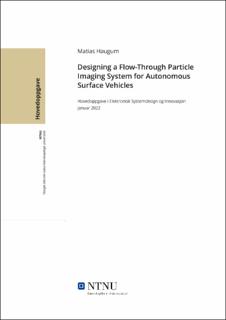| dc.contributor.advisor | Orlandić, Milica | |
| dc.contributor.advisor | Johansen, Tor Arne | |
| dc.contributor.advisor | Zolich, Artur | |
| dc.contributor.advisor | Alfredsen, Jo Arve | |
| dc.contributor.author | Haugum, Matias | |
| dc.date.accessioned | 2022-11-01T18:19:33Z | |
| dc.date.available | 2022-11-01T18:19:33Z | |
| dc.date.issued | 2022 | |
| dc.identifier | no.ntnu:inspera:104140281:36360801 | |
| dc.identifier.uri | https://hdl.handle.net/11250/3029428 | |
| dc.description.abstract | Innsamling av vannprøver er ofte gjort for h˚and, og logistikken rundt innhenting og analyse
av prøver kan være en tidkrevende prosess. In-situ partikkelavbilding ved hjelp av autonome
overflatefartøy og billedtakingsystemer kan redusere tiden til analyse betydelig, ved ˚a utelate
prøveinnhentingen. Mange slike billedtakingsystemer er derimot ikke designet for autonome bruksomr˚ader, og tillater lite rom for endring, implementasjon, eller har en høy pris.
I denne oppgaven blir designet for et partikkelbilledtaking-system for autonome bruksomr˚ader
presentert. Designet baseres rundt et mikroskop, og en pumpe beveger en vannprøve under et
forstørrende objektiv. Et kamera brukes til ˚a ta bilder av vannprøven, og en mørkefelt-kondenser
tilbyr økt kontrast sammenlignet med konvensjonelle lysfelt-kondensere. Billedmanipulasjonsmetoder benyttes for ˚a fjerne overflødig data, og til ˚a hente ut regioner av interesse i datasettene. Det
endelige systemet kan prosessere vannprøver i en fart p˚a opp til 7.8mL/min, og tar bilder med en
oppløsning p˚a 3.19µm/piksel. Testing viste at de beste resultatene ble oppn˚ad ved ˚a pumpe vannprøven i en hastighet p˚a 1.95mL/min, og benytte et lysbilde med 0.8mm dybde. Systemet koster
ca 1900e. Sammenlignet med PlanktoScope som har en oppløsning p˚a 1.5µm/piksel, samplingshastighet p˚a 1.7mL/min og pris rundt ca 500$, koster systemet mer. Likevel, med rom for flere
sensorer kombinert med en mørkefelt-kondenser, tilbyr systemet en mer tilpassbar platform for
autonome oppdrag. | |
| dc.description.abstract | Acquiring water samples is often done by hand, and the logistics surrounding the sample retrieval
and analysis can be a time consuming process. In-situ particle imaging by the use of autonomous
surface vehicles and flow-through imaging systems can significantly reduce the time to analysis, by
forgoing the sample retrieval process. Many imaging systems are however not built for autonomous
applications, and offer little room for customization, implementation, or come at high cost.
In this thesis, the design of a flow-through particle imaging system built for autonomous applications is presented. The design is based around a microscope, using a pump to move a water
sample underneath a magnifying objective lens. A camera is used to take pictures of the sample,
and a darkfield condenser offers increased contrast over conventional brightfield lighting used in
other systems. Image manipulation methods are applied to remove unwanted data, and extract
regions of interest in the data sets. The resulting system can sample at speeds up to 7.8mL/min
and capture pictures of suspended particles with a resolution of 3.19µm/pixel. Testing showed
that pumping at speed of 1.95mL/min using a channel slide of 0.8mm produced the best results.
The system has a cost of approximately 1900e. Compared to the PlanktoScope with a resolution
of 1.5µm/pixel, sample rate of 1.7mL/min, and cost of 500$, the system comes at a greater cost.
However, with room for additional sensors coupled with a darkfield condenser, the system provides
a more customizable platform catered to autonomous missions. | |
| dc.language | eng | |
| dc.publisher | NTNU | |
| dc.title | Designing a Flow-Through Particle Imaging System for Autonomous Surface Vehicles | |
| dc.type | Master thesis | |
